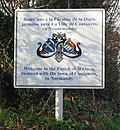Saint Ouen, Jersey
| Saint Ouën Jèrriais: Saint Ouën | |
| Jersey | |
|---|---|
 Coast of St Ouen | |
| Area: | 3,707 acres |
| Population: | 4,097 2011 |
| Island: | Jersey |
Saint Ouen is one of the twelve parishes of Jersey. It is in the north west of the Island. The parish is the largest parish by surface area, covering 8,341 vergées (3,707 acres).
Saint Ouen is reputed to be the most traditional of the parishes, being the farthest from St Helier, and since much of the parish forms a peninsula whose only neighbour is the sea. Its manor, the seat of the de Carteret family for over eight centuries, is the senior fief in the island, and the influence of that family has also been a factor in the parish's independent-minded approach to its affairs.
Sights of the parish
A number of prehistoric sites are located in St Ouen, including the dolmen des Monts Grantez, located at Le Chemin des Monts[1]; the dolmen des Geonnais[2]; and the prehistoric site at Le Pinacle[3], which also contains one of the very few identifiable Gallo-Roman sites to be seen in Jersey, the foundations of a fanum (a small pagan temple).
In the north west, the ruins of Grosnez Castle are a landmark which also features on the Jersey 50 pence coin.
The Island's racecourse is also to be found at Les Landes.
Culture



A number of the most influential writers of Jersey have been St Ouennais. George F Le Feuvre (1891–1984), who wrote under the pseudonym "George d'la Forge", was one of the most prolific authors of Jèrriais literature of the 20th century. Frank Le Maistre (1910–2002), compiler of the Dictionnaire Jersiais-Français (1966), did much to standardise the St. Ouennais dialect of Jèrriais as a literary language. Edward Le Brocq (1877–1964) wrote a weekly newspaper column from 1946 to 1964 recounting the lives and opinions of two St Ouennais characters, Ph'lip and Merrienne.
The traditional nickname for St. Ouennais is Gris Ventres (grey bellies) - a reference to the custom of men from the parish to wear jerseys of undyed wool, which distinguished them from men from other parishes who generally wore blue.
The St Ouennais and Sercquais dialects
Sark was recolonised by St Ouenais. Helier de Carteret, the seigneur of the parish, received a charter from Queen Elizabeth I to colonise Sark with 40 families from the parish on condition that he maintain the island free of pirates. Sercquiais is therefore a very old offshoot of St Ouennais Jèrriais. The St Ouennais origins of Sercquiais can be seen in the distinct 2nd and 3rd person plural forms of the preterite; Sercquiais uses an ending -dr which is typical of the St Ouennais dialect of Jèrriais, but generally not used elsewhere in Jersey (nor nowadays by younger speakers even in St Ouen).
| Sercquiais | St Ouennais | standard Jèrriais | English |
|---|---|---|---|
| i vuliidr | i' voulîdrent | i' voulîtent | they wanted |
| uu paaliidr | ou pâlîdres | ou pâlîtes | you spoke |
| i füüdr | i' fûdrent | i' fûtent | they were |
| uu prẽẽdr | ou prîndres | ou prîntes | you took |
Cueillettes
Unlike the other parishes of Jersey, the divisions of this parish are not named vingtaines, but cueillettes (Jèrriais: tchilliettes). Vingteniers are still elected, however, in the cueillettes. The six cueillettes of St Ouen are:
- La Petite Cueillette
- La Grande Cueillette
- La Cueillette de Grantez
- La Cueillette de Millais
- La Cueillette de Vinchelez
- La Cueillette de Léoville
Pictures
-
Cliffs at Plémont
-
Road sign in La Néthe Rue (the black road in Jèrriais)
-
A field entrance in St Ouen
-
St Ouen bilingual sign
-
Le Don Hacquoil
Outside links
References
| Parishes of Jersey |
|---|
|
St Brelade • St Clement • Grouville • St Helier • St John • St Lawrence • St Martin • St Mary • St Ouen • St Peter • St Saviour • Trinity |



